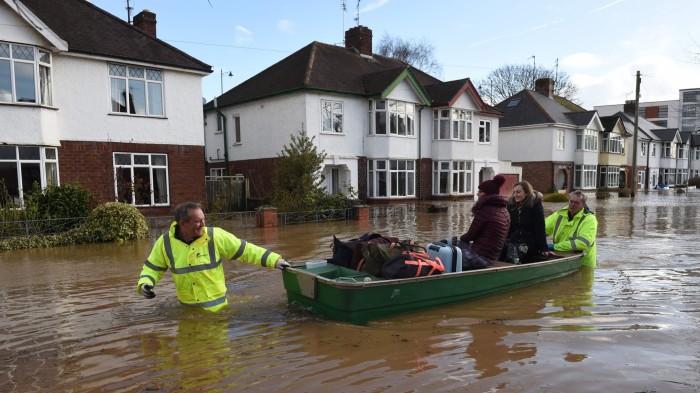Unlock the Editor’s Digest for free
Roula Khalaf, Editor of the FT, selects her favourite stories in this weekly newsletter.
One in four properties in England will be at risk from flooding by mid-century, the Environment Agency has said, after updating its modelling techniques to factor in the effects of climate change.
Flooding from rivers, the sea or surface water already puts 6.3mn properties in danger and higher global temperatures are set to push that total to 8mn by 2050, based on the agency’s latest assessment released on Tuesday.
Carola Koenig, from the Centre for Flood Risk and Resilience at Brunel University of London, said the report should “act as a wake-up call for local authorities” to pay more attention to mitigation and adaptation in conversations on planning permission.
The agency said its more pessimistic outlook was mostly down to better data, modelling and technology in its own processes.
This is the first time the Environment Agency has used the Met Office’s latest UK national climate projections to inform local flood risk models. It is also its first full update of its model since 2018.
Michael Byrne, a climate scientist at the University of St Andrews, said he was “highly surprised” at the Environment Agency’s admission that it had not previously taken these climate change projections into account when assessing flood risk.
For government, this would have made it “extremely difficult to plan for the infrastructure changes we need to meet the escalating flood risk”, Byrne said.
The findings come after Storm Bert wreaked havoc in parts of Wales, Scotland and England in November, prompting calls for more money to be spent on flood defences.
As communities recovered, the House of Commons environmental audit committee launched an inquiry earlier this month into how authorities are tackling floods and what support households and businesses need to stop being “at the mercy” of flooding.
The greatest water-related threat to homes comes from flash floods where excess rainwater overwhelms drainage systems, causing surface water run-off. This now threatened 4.6mn properties, a 43 per cent increase on the 2018 assessment, the Environment Agency said.
There had also been a dramatic 88 per cent increase in the number of homes facing the highest level of risk from flooding from rivers and the sea over that period. With a one in 30 chance of being hit in any given year, this issue now affects 367,900 properties, it said.
Coastal erosion would see 3,500 properties at risk from changing shorelines by 2055, with 10,100 facing the threat by the end of the century.
Brunel’s Koenig said she hoped planners in densely populated areas like London would embrace the “sponge city concept,” under which homeowners are discouraged from paving over driveways and gardens so that surface water is helped to drain away more effectively.
The combination of drier summers and excess rain faced by the UK also means more attention should be paid to rainwater storage, she added.
Scientists expect global warming to continue to bring more rain to parts of the world including the UK, which is traditionally wetter than average, while inflicting drought on regions with less rainfall.
Last year was the warmest on record globally, with temperatures for 2024 set to exceed that.
Read the full article here

